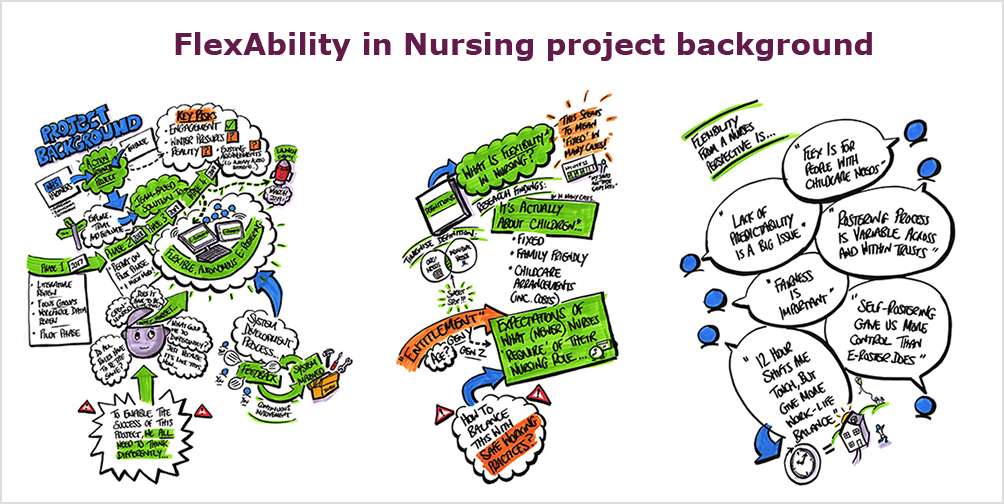

Timewise research into how care providers can improve recruitment and retention by redesigning care jobs to be more compatible with carers’ non-work lives. The report includes the findings of a workplace pilot with Rathbone, a community support provider.
Social care has a reputation for offering flexible working to suit those with personal caring responsibilities and indeed 53% of the care workforce work less than full-time. But equally, it requires unsociable hours – early mornings, evenings and weekends. Up to 60% of workers in domiciliary care are on zero hours contracts: in theory, such contracts enable carers to choose both the schedule of hours they work, and the amount of work they do each week. But does the rhetoric of flexibility and family-friendly match the reality of carers’ jobs?
Timewise, with the support of the JPMorgan Chase Foundation, set out to explore how care providers manage the challenge of delivering a high quality service to people who need care, whilst enabling carers – 82% of whom are women – to find the flexibility they need to manage their own non-work responsibilities.
The purpose of the pilot phase of our research was to test whether a geographical team-based approach to scheduling could stabilise and enhance jobs in care. The pilot showed that:
Published May 2017
1.5 million people currently work in low-paid roles in retail, and the majority work part time. Flexibility in working hours is one of the most important reasons cited for choosing to work in retail. However, much talent is wasted because retail staff who need to work flexibly or part-time are trapped in junior jobs: they cannot take their flexibility with them to progress to store management level.
Timewise, supported by the UK Futures programme and working alongside Pets at Home plc, piloted the redesign of retail management roles on a flexible and part-time basis. The aim was to find out if greater access to flexible working could unblock the retail talent pipeline and address diversity issues.
The project also aimed to identify a process for implementing wider access to flexible working, for other retailers to follow.
Pets at Home employs 8,000 store-based colleagues of whom 65% are women. The business suffers from high attrition rates for women. Research amongst employees found that:
Through data mapping, surveys and listening groups, and analysis of operational practices, Timewise helped Pets at Home to identify the challenges and opportunities within the business. The board made a commitment to job redesign for managerial roles, and set up a steering group to run the change process. Training for managers helped to facilitate the new approach, and role models have been championed through internal communications channels.
Through the pilot, Timewise developed a guide for retailers interested in using flexible working as a means to improving talent retention and progression. We recommend a five-stage process to implement flexible job redesign in retail management roles:
Published November 2016
 As the NHS reaches its 70th birthday, the workforce challenges it is facing are well publicised. It is harder than ever for the organisation to attract and retain talented people, and the resulting vacancy levels are compounding workload and stress levels for those who remain.
As the NHS reaches its 70th birthday, the workforce challenges it is facing are well publicised. It is harder than ever for the organisation to attract and retain talented people, and the resulting vacancy levels are compounding workload and stress levels for those who remain.
Here at Timewise, we know that one of the key tools for attracting and retaining talent is offering a level of flexibility. Today, 9 out of 10 employees want to work flexibly or part-time. And the importance of flexibility is starting to land with NHS policy makers, too.
In a recent speech on the future of the NHS, the Prime Minister commented that “working practices in the NHS have not caught up with modern lifestyles…we must also take better care of staff and offer greater flexibility over where they work, when they work and what they can do.”
Clearly, implementing flexible working in a 24-hour organisation like the NHS is not straightforward. With different specialisms and departments having such different operational needs, there is no one-size-fits-all solution. So, drawing on our advisory work with five NHS Trusts and supported by the NHS Leadership Academy and NHS London Women’s Network, we have investigated the challenges, opportunities and areas for action.
The resulting report, Flexible Working in the NHS: The Case for Action, captures the key business case for flexible working in the NHS, provides some case studies to highlight new approaches, and sets out a clear action plan for the next steps that would achieve fundamental change in approach.
As the report shows, NHS staff who wish to work flexibly are often treated as an inconvenience, due to needing something different which managers have to accommodate. The cultural expectation that NHS employees will be 100% committed to their roles also makes it hard for people who need to work less, or only work at certain times.
So, if the NHS is to overcome its staffing issues, there needs to be a mindset change. Rather than treating flexible working as a favour for people with caring responsibilities, leaders should view it as a valuable workforce tool. Why? Because giving more people greater control over when and how much they work will lead to greater engagement, improved wellbeing and increased productivity. And of course, it will make it easier for NHS Trusts to find and keep the staff they need.
As the NHS celebrates its past, and looks ahead to the future, we believe that flexible working has a key role to play in addressing its workforce challenges. By prioritising flexible job design and creating a culture that supports flexibility from the top down, NHS leaders will be far better placed to deliver a health service that is future fit.
Download full report - Flexible Working in the NHS: the Case for Action
To find out how Timewise could support your organisation, please email info@timewise.co.uk
Published July 2018
By Emma Stewart, Co-Founder
At Timewise, we don’t believe that flexibility should come at any price; our focus is on delivering good quality flexible roles. But, as the Institute for Fiscal Studies stated in their 2018 report, “not working full time tends to shut down wage progression.” As a result, too many people end up trapped in entry-level roles, which are poorly paid, because they can’t get the flexibility they need higher up the scale.
One sector that illustrates this perfectly is retail. It employs around three million people, and has a higher incidence of low pay than any other sector. According to the British Retail Consortium’s 2020 research, flexibility in working hours is one of the main reasons people choose to work in the sector – but 56% of retail employees believe they are less likely to get promoted if they work part time.
As a first step towards tackling this problem, we partnered with the Joseph Rowntree Foundation and five major retailers to run our Retail Pioneers programme, a piece of action research followed by a written report. Launched last May, it set out to help each retailer understand what was getting in the way of flexibility at store management level, and then design and develop management roles with compatible flexibility built in.
As my colleague Amy Butterworth explains elsewhere, the programme has already begun to deliver real change for our pioneer partners, with each of them taking action to design flexible jobs differently. And that’s brilliant – but it’s not the end of the story. Our initial learnings can also be used by the rest of the retail sector and beyond, to tackle the structural barriers that prevent the progression of low-paid part-time workers. For example:
Initially, some of the pioneers were uncertain about working so closely with other retailers. But as the programme progressed, the benefits of the group approach became clear. The pioneers got valuable insights from sharing their experiences, and regularly challenged each other’s assumptions and assertions.
We all know by now (or we should) that the lack of women in senior roles contributes to the gender pay gap. But that doesn’t mean we should focus all our attention on moving women from middle-management upwards.
Helping women progress from entry-level roles to line management – as our retail pioneers are now doing – will also help close the gap. And building more gender-balanced workplaces makes good business sense for employers too.
During the programme, our five pioneers all came to the same conclusion: that building flexibility into management roles could aid progression for retail team members, enabling them to maximise their skills whilst retaining their flexibility.
However, each retailer had different factors to take into account, and so needed to develop their own individual solution, grounded in their own business. When it comes to flexible job design, there is no one-size-fits-all solution; each organisation needs to take a bespoke approach based on its specific data and drivers.
So far, so good. But, as useful as these learnings are, they need to be championed at a macro level if they’re to deliver real, systemic change.
I’m kick-starting this by joining a government taskforce looking at flexible working, in response to the Taylor Review on modern work. However, far more needs to done by government, employers and industry bodies to create better quality part-time and flexible roles.
Many employers are unaware that the lack of part-time and flexible options at management level traps skilled, ambitious employees in low-paid jobs. And even those who agree that flex is the answer may not know how to get started or, in tight margin sectors, have the resources to do so.
If we are going to answer the Taylor Review’s call for better flexible work which benefits both employers and employees, delivered at scale, then we need more involvement and investment from government, civic society, and other industry bodies. Here’s what needs to happen:
Our work has highlighted a real lack of evidence about what works, without which it will be difficult to persuade employers to take – and critically, invest in – action. It has also revealed the importance of having a road map which sets out HOW employers can design better flexible and part-time jobs, at all levels.
If we are serious about building a fairer jobs market, and helping people trapped in low-paid roles to progress their careers and raise their living standards, we need government to commit to investing in it. This will allow us to test a range of approaches and use our findings to incentivise further business action, something which is particularly critical in low-margin sectors where the business case for change is not well established.
At a regional level, LEPs and metro mayors also have a part to play in sharing good practice and stimulating action to create better quality part-time jobs. This will support their inclusive growth strategies and help create fairer workplaces.
Our Retail Pioneers programme has benefitted hugely from our partnership with the BRC. They played a pivotal role in helping us get the programme off the ground, and are continuing to work with us to develop practical flexible working solutions.
Most industries have an equivalent organisation or body; the more of them that invest in championing flexible working, the greater the impact will be.
Our pioneers found that taking a deep dive into their workforce data threw up some surprises; in the words of Lesley Ballantyne from The John Lewis Partnership, “the programme has brought issues to the surface that we previously only had an inkling of.” Our consultancy team offer a flexible audit which can help support this process.
Underpinning all this, we need a space in which innovative practice can be designed and developed. We invest in innovation for R&D and technology; it’s time we started investing in innovation for designing good quality work. So this autumn, we’re launching the Timewise Innovation Unit, to create a forum in which this can happen.
By doing so, we will be able to help more employers design the flexible jobs that will progress their workers, maximise their skills and ultimately create more productive workplaces. I’m really looking forward to driving this change through the Innovation Unit, and I hope you’ll get involved; watch this space.
To find out more or get involved with the Timewise Innovation Unit, please contact Emma on 020 7633 4444 or email info@timewise.co.uk
Published May 2018
 By Amy Butterworth, Principal Consultant, Timewise
By Amy Butterworth, Principal Consultant, Timewise
It’s just over a year since we launched our Retail Pioneers programme, supported by the Joseph Rowntree Foundation and endorsed by the British Retail Consortium. An innovative piece of action research, it focused on embedding flexibility into store management roles, to create a pathway for progression for retail team members who need to work in this way.
Now, as the programme draws to a close, we’ve written a report setting out what we and the pioneers have learned, which we hope will help steer other organisations in the right direction.
The programme was carried out in partnership with five pioneer retailers: B&Q, COOK, Dixons Carphone, Tesco and The John Lewis Partnership, led by our team of flexible working specialists. We began by bringing them together to discuss the issues they were facing, share their insights and challenge each other’s assumptions and assertions. We then worked with them individually, using our experience to help them understand what their data was telling them and explore potential routes for change.
The feedback we’ve had from the pioneers has been universally positive. It’s clear that the programme was immensely useful, helping them get to grips with the issues they knew about and highlighting others that they didn’t know they had, as well as developing practical, personalised solutions. Or, in the words of Alison Payne, Cook’s Head of People Operations:
“Working with Timewise on the Retail Pioneers programme has given us a rich understanding of the business case for flexibility in our stores, and the potential benefits for our people and our organisation.”
Whilst the programme revealed some recurring themes which were common to all of the retailers, it also underlined the importance of developing bespoke solutions for each one. All their business models are different and so their requirements are too; when it comes to flexible working, it’s clear that there is no one-size-fits-all solution.
As a result, the five pioneers are exploring a range of actions tailored to their particular organisation. From Tesco’s piloting of a team-based approach to flexible job design, to Cook’s creation of a bank of flexible and part-time job descriptions, each one is rooted in the needs of their business and their workforce.
As for us, we believe this is just a starting point. We’re keen to see more retailers, and other sectors, taking a similar approach to delivering flexible roles at management level, and my colleague Emma Stewart is calling on government to invest in making it happen. We’ll keep you posted.
You can read more about the approach each of the pioneers is taking in the full report.
If you would like to take part in a similar programme, or find out more about our flexible audit service, please call 020 7633 4444 or email info@timewise.co.uk
Published April 2018
 We’re now at a particularly exciting point in our FlexAbility in Nursing project, a piece of action research into how flexible working could bring about the change the profession needs.
We’re now at a particularly exciting point in our FlexAbility in Nursing project, a piece of action research into how flexible working could bring about the change the profession needs.
Having explored the issues with the existing system, and subsequently identified team-based rostering as the preferred approach, we’re now part-way through the pilot stage. Our team have been working with over 100 staff across three wards at Birmingham Women & Children’s Hospital to build their first rosters.
Team-based rostering has already been shown to work in a number of similar sectors, such as social care, but the need to have a fully staffed ward at all times required a bespoke approach for nursing.
We have therefore designed a new way of creating each roster, using a ‘lead team’ on each ward, each of whom represents a group of colleagues. The lead team members are responsible for liaising with their colleagues to populate a draft roster, based on individual preferences and requirements, and then collaborating with them further to negotiate an agreed version.
Our aim was that the new system would create much higher engagement from individual team members, and that has proved to be the case. Personal communication about work-life needs and preferences is more adaptable than the previous system of requests being input into a ‘system’ each month.
The feedback we’ve received so far is that individual nurses feel empowered by their ability to get involved, and are taking more responsibility for managing any changes. For example, one ward manager told us:
“I got a text this week saying ‘I need to change my shift, but don’t worry, I’ve already done it.’ Before, this request would have come through to me to sort out; instead, the nurse has worked with her team to find a solution. That’s a great result.”
The pilot has also indicated that the nursing staff see team-based rostering as a fairer system which gives everyone a chance to have some flexibility in their schedules, rather than just those on formal flexible working arrangements (FWAs) which are often only granted to those with childcare responsibilities.
For example, one junior sister explained that, under the previous system, she ended up taking on a disproportionate amount of unpopular shifts, because she didn’t have any specific caring responsibilities or a FWA.
The new system has created an understanding that everyone has to take their fair share of the less popular shifts, and that other responsibilities and preferences (such as being a Brownie leader, taking care of one’s own health, or attending a weekly class) are equally valid.
A third major benefit of the new system is that people have grasped how complicated it is to put a nursing roster together. As a result of working as a team to find the best solution, the nurses now appreciate the effort required to account for all the skills mixes and working requests, and are more prepared to be flexible themselves.
However, as we expected, the pilot has also highlighted some challenges which we need to address as we move forward to the next stage. These include:
In most cases, the lead team members didn’t have any previous experience in leading 1:1 conversations, and were unsure about how to discuss work-life balance and working preferences. Some felt they just needed to write down the shifts people wanted rather than having a dialogue. Others weren’t sure how to handle talking to their colleagues about their personal circumstances.
As a result, we’ve been spending individual time with lead team members who need support to develop these skills, and role playing conversations they can have as they negotiate their next roster.
There were real differences in the length of time that lead team members took to create the draft roster, ranging from 30 minutes to three hours.
This time will reduce as the nurses become more proficient at using the roster technology, but for the future pilots, we plan to incorporate additional training on the most efficient way to create a roster, prior to the first ones being built.
For some groups, such as clinical support workers, who work in small teams which don’t tend to overlap, it was difficult for lead team members to get face to face time with their colleagues to discuss their preferences.
For the purposes of the first pilot, this was tackled using technology such as WhatsApp, and by fitting in meetings just before or just after their shifts. However, we will talk to the team about alternative ways to manage this issue before the next stage.
Some of the participants took a while to understand the collective nature of team-based rostering – that is, it isn’t just about what you want, but about working as a team for the best overall outcome.
We’ve tackled this by making sure we restate the principles throughout the process, and working particularly closely with individuals who are more resistant to change.
The pilot runs until June, and will cover the creation of four rosters for our three wards. We will continue to measure the impact of the new system, using a range of data, and to assess and refine our approach. We will then make final recommendations for a second round of pilots at Nottingham University Hospital and University Hospital Southampton, which are due to start in the summer.
We’re delighted with the progress that we’re making, and the lessons we’re learning from this project; we can already see the potential for building a fairer, more sustainable system that will help tackle the shortages in the nursing sector. We’ll continue to share our findings with you at every stage.
To find out more about the innovative research opportunities we offer, contact info@timewise.co.uk or call 020 7633 4444.
Published March 2018
 In 2016, as part of a revaluation of their working practices, Westminster City Council decided to remodel their City Hall base. Their aim was to make it a better working space for their own staff, and to make part of it available to rent, as a way of generating extra income.
In 2016, as part of a revaluation of their working practices, Westminster City Council decided to remodel their City Hall base. Their aim was to make it a better working space for their own staff, and to make part of it available to rent, as a way of generating extra income.
From a practical point of view, this required them to reduce their desk-to-person ratio, by encouraging more employees to work flexibly. But the team at Westminster quickly realised that they needed to tackle their workplace culture if flexible working was to be successful. So, having spoken to their colleagues at Camden, who had been on a similar journey to become the first accredited Timewise Council, they contacted us for support.
As Aruj Haider, OD Advisor for Westminster explains, “We soon worked out that the office move was an opportunity to transform the way we work. We wanted to find the best way to build flexible working into our strategy, and knew we’d do a better job if we had some expert advice.”
The Timewise programme lasts around four months, and aims to help the council create a flexible working improvement plan, through which they not only become more flexible themselves, but also use their experience to influence other local employers.
The team at Westminster were keen to get input from across their organisation, so they set up an agile working group that was led by John Quinn, Executive Director of Corporate Services, and had representatives from different departments, who were tasked with getting involved. And critically, the programme also involved engaging the top team. As John explains:
“We knew if we were going to make flexible working a success, we’d need to ensure that any culture change was implemented across the board. The leadership workshops were particularly valuable as they’ve made sure that the focus on flexible job design starts right at the top.”
So what has changed at Westminster since they started the programme? The answer is, a great deal.
Today, ‘agile working’ (the term they use internally) is at the heart of their strategy. They’ve developed a clear leadership vision around it that encourages trust and focuses performance management on outcomes, not inputs. They’ve created principles and protocols so that everyone is clear about what agile working involves, and developed an agile working hub where everything agile sits together, including a tech toolkit to support staff who are out there doing it.
And that’s just a snapshot; the change is being led from the top but is cascading down through the council at every level.
But the team know that this isn’t the end – it’s just the beginning. As Aruj points out:
“Understanding the issues around flexible working and culture isn’t a quick fix. We need to make sure everyone in our organisation remains clear about the benefits of working flexibly, so they are aware of, and take advantage of it; it’s a case of repeat repeat repeat.
“Flexible hiring is obviously critical, so we need to continue our work in this area too. We’ve already created resources to support flexible hiring, and are planning a workshop on flexible job design for our HR leaders. “This is all part of our drive to ensure that Westminster is a fair, inclusive and diverse place to work”.
So, what advice does John have for other councils or organisations who are considering a similar move? “Start as early as you can. It does take time to change mindsets and it’s worth making sure you don’t have to rush the process.
“My other piece of advice would be to get some expert help; Timewise’s support has been invaluable. They have helped us to think differently about how to make jobs truly flexible, got the senior team really engaged and have brought the concept of flexible working to life in a way that helps everyone buy into it. I’d definitely recommend the accreditation programme for councils.”
To find out more about becoming a Timewise Council or the other ways that Timewise could support your organisation, please call 020 7633 4432 or email info@timewise.co.uk
Published March 2018
 The British Retail Consortium has identified that flexibility is one of the main reasons why people choose to work in retail. But, as retailers are only too aware, the number of people working flexibly at management level is a fraction of those in customer-facing roles.
The British Retail Consortium has identified that flexibility is one of the main reasons why people choose to work in retail. But, as retailers are only too aware, the number of people working flexibly at management level is a fraction of those in customer-facing roles.
So when we asked the retail community whether they would be interested in being part of our Retail Pioneer Programme, we were delighted by the response. Five major retailers immediately spotted the potential value of the programme to their business, of which John Lewis Partnership was the first to sign up. As Lesley Ballantyne, John Lewis Partnership’s Partner Proposition and Experience Director, explains:
“We had seen how the work Timewise had carried out on a previous pilot programme had deepened the retailer’s understanding about how to incorporate flexible working into a retail business. So we took the opportunity to go on our own flexible journey through the Retail Pioneer Programme.
“We had a hunch that the lack of flexible working options at management level was preventing our partners from progressing their careers. So we agreed to focus the programme on making first-line management roles work on a flexible basis, to allow non-managers who need flexibility to move into these roles.”
The first stages of the programme involved looking at the business case for flexibility, and assessing the firm’s capacity for change. We conducted a series of focus groups and a staff survey, with the aim of identifying the level of satisfaction with current flexible provision, the latent demand for flexibility, and whether career progression on a flexible or part-time basis was considered a realistic possibility.
And their insights were revealing to say the least, says Lesley:
“It was really useful to get input from an external agency with specific expertise in flexible working. The resulting research certainly opened our eyes to our partners’ perceptions, as well as challenging our assumptions.
“For example, while we were aware of the impact that general pressures on the retail industry are having on line managers’ workloads, the fact that this would make flexible working feel even less achievable was a barrier we hadn’t anticipated.”
Based on the insights revealed by the research, we recommended several options for implementing flexible working at a first-line management level. And we were delighted when the John Lewis Partnership team opted to pilot a team-based approach to designing and rostering these roles across five of its stores. As Lesley explains:
“Our stores operate on a 60+ hour week, so no one really works ‘full-time’ in a traditional sense. That should make it possible for our first-line managers to decide together how to staff their store, based on the flexibility each one of them needs, rather than have rosters imposed on them.”
And she is hoping that the pilots signal the beginning of a new flexible era for John Lewis Partnership:
“If we can demonstrate that this level of flexibility isn’t just possible, but preferable, and create role models who are doing it successfully, then we’ll be able to incorporate this into our hiring practices too. So, when we have a vacancy, we’ll be able to invite candidates to bring their own flexible preferences into work. That’s a powerful incentive to come and work with us.”
So, what advice would Lesley give to other organisations who would like to develop their own flexible working approach?
“We knew that we couldn’t just wave a magic wand to make flexible working a success, so it has been really helpful to have Timewise supporting us on the journey. Their independent and professional approach applied a laser-like focus to the issue and gave us a much richer insight than we could have achieved alone.
“I’d advise other organisations to be open-minded about the barriers to and effects of flexible working, and to be prepared to have their assumptions challenged; the programme has brought issues to the surface that we previously only had an inkling of. We thoroughly enjoyed working in partnership with the Timewise team and feel that we understand our business better as a result.”
If you would like to know more about our flexible consultancy services, or discuss how you might benefit from working with Timewise, please call 020 7633 4444 or email info@timewise.co.uk
Published January 2018
 By Emma Stewart, Co-Founder
By Emma Stewart, Co-Founder
I’ve long been troubled by the fact that the teaching profession appeared to be lagging behind other sectors in their approach to part-time and flexible working. And the constant trickle of headlines highlighting teaching staff shortages has only reinforced my conviction that something needs to be done.
So I was delighted to be invited by Justine Greening MP, the Secretary of State for Education, to attend her department’s recent Flexible Working in Schools summit, and share Timewise’s experience and insights in flexible working, hiring and job design with the panel.
As we know from our research into today’s flexible workforce, a staggering 87% of the UK workforce either works flexibly already, or would like to. And a previous piece of research into women returners highlighted that 58% of those coming back to work after a year or more would prefer a part-time role.
Yet, as figures shared at the summit showed, while 42% of working women in the UK work part-time, only 25% of female teachers do. And given that only 9.7% of primary school jobs and 6.6% of those in secondary schools were advertised as part-time last year, that’s hardly surprising. Other kinds of flexible working, such as compressed or staggered hours appear to be even less common.
It’s clear, then, that there’s a big gap between flexible supply and demand in teaching, and between teaching and other sectors. So the key question is, why? The panel were agreed that the two biggest barriers are a logistical one of timetabling and a more cultural one of mindset. In both cases, having buy-in from senior leadership teams, and role models setting examples, were considered critical to closing the gap.
Certainly, there are pockets of flexible excellence within teaching, and some fantastic role models too. Liz Robinson and Nicola Noble, co-heads at Surrey Square Primary School who attended the summit, are just one example. But as is often the case, they took the initiative to create their arrangement themselves; it wasn’t an advertised role.
Yet, when schools are prepared to hire flexibly, it pays off. TES Global have found that job adverts that mention the words part-time get 13% more interest than those that don’t; given the fierce competition for the best talent, that’s well worth considering. The uplift doesn’t stop once the staff are on board either: research for ACAS by the University of Manchester has found that flexible working increases both personal and team effectiveness. And it has been shown time and again to have a positive effect on retention and motivation of staff in all sectors.
Of course understanding the problem is only half the battle; now we need to fix it. And the good news is, the will to do so starts at the very top. Ms Greening has pledged action from the DfE, including:
It’s important that those working across the profession, from multi-academy trusts and governing bodies to teaching unions, are empowered and supported to take action too.
That means testing new ways to help headteachers design jobs with flexibility built in. It means trialling new approaches to designing part-time and flexible jobs, which still work within the school timetable and maintain quality teaching standards. It means equipping senior leaders to build a business case for part-time and flexible working, and create a culture in which it’s both acceptable and achievable. And it means advertising teaching roles as flexible up front, rather than waiting for staff to ask.
The Flexible Working in Schools summit felt like a watershed moment for the teaching profession – and I was delighted to be part of it. But it’s just the beginning; the hard work starts now.
If you would like to know more about the work we do at Timewise, please call Emma on 020 7633 4444 or email info@timewise.co.uk
Published November 2017
 The staffing crisis in the NHS is in the news more often than any of us would like. From the fact that more nurses are leaving the profession than joining, and the drop in the number of EU nurses registering to work in the UK to the potential impact of British expat pensioners returning home, there’s little doubt that something needs to be done to attract more people into the profession – and to keep the nurses we already have.
The staffing crisis in the NHS is in the news more often than any of us would like. From the fact that more nurses are leaving the profession than joining, and the drop in the number of EU nurses registering to work in the UK to the potential impact of British expat pensioners returning home, there’s little doubt that something needs to be done to attract more people into the profession – and to keep the nurses we already have.
So the time really is right for a root-and-branch look at how nursing works in practice, in terms of workload, scheduling and nurses’ ability to balance work with other responsibilities. Our new FlexAbility in Nursing project, which we’re running in conjunction with three leading hospital trusts (Birmingham Women’s & Children’s Hospital, Nottingham University Hospital and University Hospital Southampton), will deliver exactly that.
The project, which is supported by funding from the Burdett Trust, is a piece of action research into how flexible working could bring about the change the profession needs.
The first stage of the project is now complete. It involved a literature review and a series of focus group sessions, designed to understand how flexible working is defined within the NHS, what the barriers are, and how to overcome them. One of the key learnings to come out of this stage is that flexibility means very different things to different stakeholders.
So, from the employer’s point of view, flexibility is seen as a way to achieve efficiency and save costs – particularly bank and agency costs. In an ideal world, all staff would be ‘fully flexible’, and able to fill rota gaps at short notice, so that the right staff are in the right place at the right time.
But many nurses are coming at it from a different direction. When rotas vary wildly from one week to the next, it’s difficult to plan a life. So for them, flexible working means working within an agreed, predictable framework and, in some cases, working fewer hours. For example, nurses who are parents may want to work fewer shifts a week, and need these to be on the same day and same time each week so they can arrange childcare. Flexibility, for nurses, needs to be fixed.
It’s clear then, that the gap between what employers and employees require from a flexible working solution is a tough one to bridge. And the way it’s organised now isn’t working for anyone.
The current variable rota system doesn’t give many nurses with other responsibilities the fixed working arrangement they need; in the words of one nurse who we spoke to: “If you have kids, you need a partner who’s flexible, or a family who can do care. If you don’t have that, you can’t be a nurse.” Other nurses are equally disillusioned, feeling that they get given an unfair amount of the unsocial hours.
Nor does it give managers enough choice about how to organise their shifts; as one told us: “Once you’ve done the skill mixes and the formal flexible working arrangements, it leaves no choice about who does the other shifts.”

It’s no wonder, given this mismatch of needs, that the profession is struggling to attract and recruit enough staff. So the next step in our programme is to find a new approach that works for everyone: giving nurses the right kind of flexibility to suit their work-life balance needs and keep them in the profession, whilst allowing managers to deliver efficient and effective resourcing. And of course, as a result, encouraging more people to become nurses.
We’ll do this by designing a team based approach to scheduling rotas, and then piloting it. We’re working on the design right now; once it’s finalised we’ll pilot it first with three wards at Birmingham Children’s Hospital early next year. We’ll share our learnings at both stages of the process, so if you’re in the nursing profession – or if it matters to you that the NHS is properly staffed – watch this space.
To find out more about the innovative research opportunities we offer, contact info@timewise.co.uk or call 020 7633 4444
Published November 2017